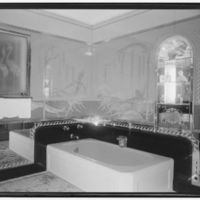The Next Phase of Transition for the Okies
The development of sanitation and plumbing codes enabled the pervasiveness of indoor plumbing and necessitated a public interest in health and sanitation. This type of connectedness within the sewage system would not be possible with the way homes were lain out in the Midwest. As communities were developed into the decades after the Okie migration one can see the distinct shift in the way they were structured and organized. Homes were now close together, just one of many within a community. Bathrooms and toilets were not excluded from this transition and it is amazing to see the differences in the way they were structured in modern homes compared to the privies in the Midwest.
Labor camps that families like the Joads resided in upon their migration into California reflected the way that homes and communities would be developed as the Joads and the rest of the Okies spread out and settled into various areas of California. Homes would be connected with sewers and plumbing. As America moved into the 1940s flushing toilets like the ones Ruthie and Winfield experienced in sanitary unit #4 would become old hat. As figure 1 in James Lutz’s article, “Lest We Forget, a Short History of Housing in the United States” shows, the amount of homes with flush toilets increased dramatically as America moved into the 40’s, 50’s and beyond
So much of Steinbeck’s novel is focused on the way that individuals manage change. The Joads are a model for the type of transition most Okies were experiencing during the Dust Bowl era and their experience with toilets and plumbing was just one manifestation of this struggle. There is a constant tension throughout the novel of balancing values and aspects of one’s past with the prospects of the future. The Joads have to figure out what to hold on to, what to let go, and what to embrace about the future. This is beautifully articulated by Tom upon the Joad’s entrance into California, “They wouldn’t of saw nothin’ that’s here. Grampa would a been a-seein’ the Injuns an’ the prairie country when he was a young fella. An’ Granma would a remembered an’ seen the first home she lived in. They was too ol’. Who’s really seein’ it is Ruthie an’ Winfel’” (313). The young people in the family are the ones who will embrace the transition, overcome the tension, and effectively come to terms with the shift in culture, community and the dynamics that contribute to those entities. I feel that this is why Ruthie and Winfield are the first to experience the plumbing in the labor camps.
It’s hard to imagine that everyone wouldn’t embrace the more modern bathing and waste disposal facilities, but some of the changes that these advancements represent might be difficult to accept. Toilets, plumbing, bathing, and sanitation all demonstrate the ways that individuals were moving away from self-reliance and self-determination and into a culture and society where people were dependent on one another for goods and services, dependent on one another for the health of their families, and dependent on the cooperation of others to make important decisions that affect entire communities.





